
Whitehaven is a town and port on the west coast of Cumbria, near the Lake District National Park in England. Historically in Cumberland, it lies by road 38 miles (61 km) south-west of Carlisle and 45 miles (72 km) to the north of Barrow-in-Furness. It is the administrative seat of the Borough of Copeland, and has a town council for the parish of Whitehaven. The population of the town was 23,986 at the 2011 census.

English Electric DP1, commonly known as Deltic, was a prototype 3,300 hp (2,500 kW) demonstrator locomotive employing two Napier Deltic engines, built by English Electric in 1955.
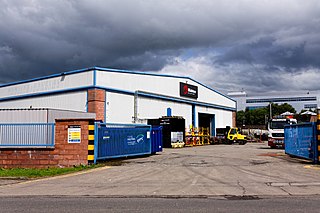
Andrew Barclay Sons & Co., currently operating as Brodie Engineering, is a builder of steam and later fireless and diesel locomotives. The company's history dates to foundation of an engineering workshop in 1840 in Kilmarnock, Scotland.

The Sydney and Louisburg Railway (S&L) is a historic Canadian railway. Built to transport coal from various mines to the ports of Sydney and Louisbourg, the S&L operated in the eastern part of Cape Breton County, Nova Scotia. The railway uses a slightly different spelling for the town of "Louisbourg".
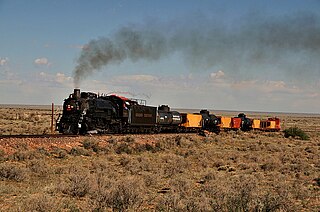
The Grand Canyon Railway, is a heritage railroad which carries passengers between Williams, Arizona and the South Rim of Grand Canyon National Park.

The Durango and Silverton Narrow Gauge Railroad, often abbreviated as the D&SNG, is a 3 ft (914 mm) narrow-gauge heritage railroad that operates on 45.2 mi (72.7 km) of track between Durango and Silverton, in the U.S. state of Colorado. The railway is a federally-designated National Historic Landmark and was also designated by the American Society of Civil Engineers as a National Historic Civil Engineering Landmark in 1968.
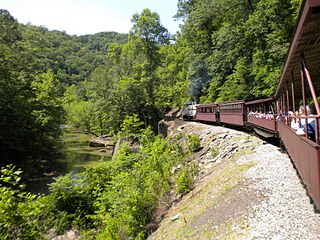
The Big South Fork Scenic Railway is a heritage railroad in Stearns, Kentucky.

Plaster City is an unincorporated community in Imperial County in the U.S. state of California. It is located 17 miles (27 km) west of El Centro, at an elevation of 105 feet.

The Lake Superior and Ishpeming Railroad, a U.S. railroad offering service from Marquette, Michigan, to nearby locations in Michigan's Upper Peninsula, began operations in 1896. The LS&I continues to operate as an independent railroad from its headquarters in Marquette.

Threlkeld is a village and civil parish in the north of the Lake District in Cumbria, England, to the east of Keswick. It lies at the southern foot of Blencathra, one of the more prominent fells in the northern Lake District, and to the north of the River Glenderamackin. The parish had a population of 454 in the 2001 census, decreasing to 423 at the Census 2011.
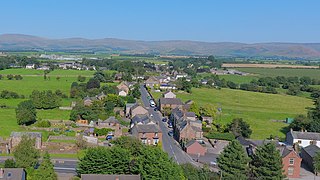
Kirkby Thore is a small village and civil parish in Cumbria, England, in the historic county of Westmorland. It is close to the Lake District national park and the Cumbrian Pennines. It includes the areas of Bridge End, in the south west by the A66, and Cross End in the north east of the village. At the 2001 census the parish had a population of 731, increasing to 758 at the 2011 Census.

The Honister Slate Mine in Cumbria is the last working slate mine in England. Quarrying for Westmorland green slate has been taken place in the area since 1728. Apart from the mining, it is also a popular tourist attraction in the Lake District National Park.
Kirkby Stephen East railway station was situated on the South Durham & Lancashire Union Railway between Barnard Castle and Tebay. It served the town of Kirkby Stephen in England and was a junction station for the Eden Valley Railway.

Long Meg Mine is a disused gypsum mine just north of Little Salkeld, Cumbria in the area known as Cave Wood Valley. It was operated between 1880 and 1976.

Stainmore Railway Company is a volunteer-run, non-profit preservation company formed in 2000 with the aim of restoring Kirkby Stephen East railway station in Kirkby Stephen, Cumbria, England. In 1997 a company called Stainmore Properties Ltd. was formed, with the intention to convert KSE into an authentic North Eastern Railway focused heritage centre representing the early 1950s. The Stainmore Railway Company was subsequently formed to restore the site. Since then essential repairs have been made to the roof and station, a number of rooms have been restored and a short section of track has been laid along the formation of the old Eden Valley Railway, with some sidings and yard infrastructure within the station area and surroundings. A quantity of rolling stock that is authentic to the site has also been brought in.
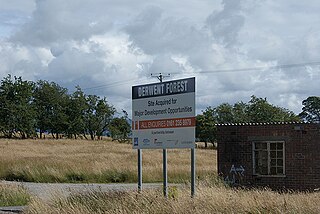
RNAD Broughton Moor is a decommissioned Royal Naval Armaments Depot located between Great Broughton and Broughton Moor in the County of Cumbria, England.

Rowrah is a village in Cumbria, England, and spans the civil parishes of Arlecdon and Frizington and Lamplugh. The majority of Rowrah is within Arlecdon and Frizington. The parish boundaries are formed from the Windergill Beck and Colliergate Beck: as such nine properties, Rowrah Hall Farm, Rowrah Hall, Ainsdale House, Rowrah Head, four properties on Pheasants Rise and Rowrah Station technically fall within Lamplugh.

Cotehill railway station was a railway station on the Settle-Carlisle Railway in England between Armathwaite and Cumwhinton. The line opened for passengers in 1876. The station was designed by the Midland Railway company architect John Holloway Sanders.
Beckermet Mines railway station was situated at Pit No.1 of the mine of the same name. It was used by workmen's trains which travelled along a branch which curved eastwards off the Moor Row to Sellafield line, primarily to handle the iron ore lifted at the site.
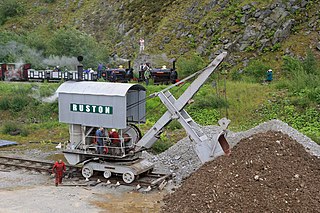
The Threlkeld Quarry and Mining Museum is located in Threlkeld three miles (4.8 km) east of Keswick, in the heart of the Lake District in Cumbria. It is suited for families, school classes and enthusiasts. It includes a quarry with a unique collection of historic machinery, such as locomotives and cranes, an underground tour of a realistic mine, a comprehensive geological and mining museum and mineral panning.




















